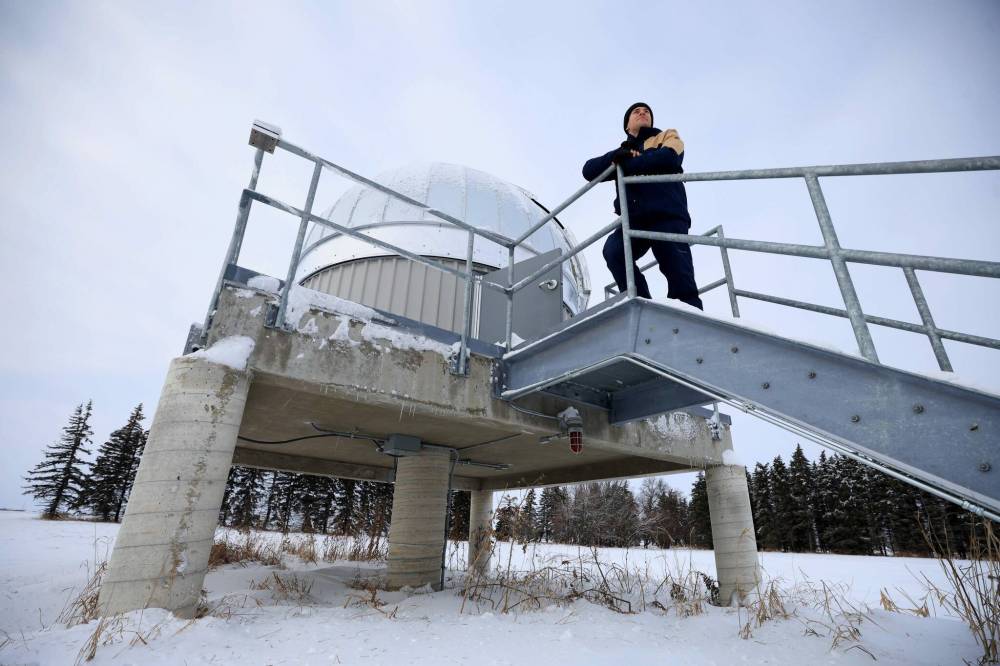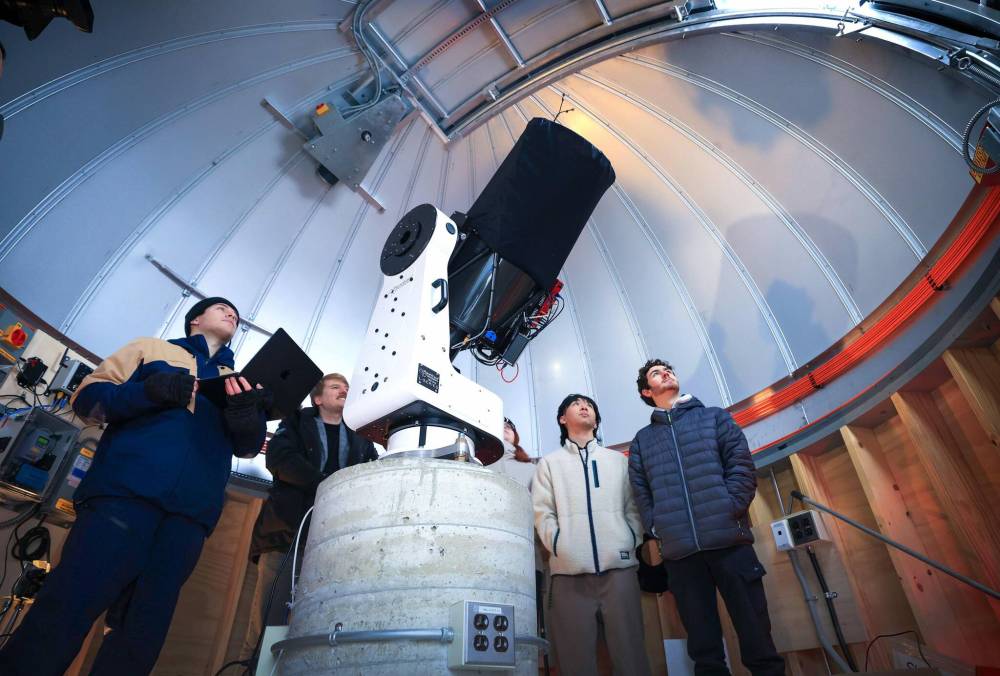U of M astronomy students get out-of-this-world upgrade
Observatory offers 360-degree view of skies, can be accessed remotely
Advertisement
Read this article for free:
or
Already have an account? Log in here »
To continue reading, please subscribe:
Monthly Digital Subscription
$0 for the first 4 weeks*
- Enjoy unlimited reading on winnipegfreepress.com
- Read the E-Edition, our digital replica newspaper
- Access News Break, our award-winning app
- Play interactive puzzles
*No charge for 4 weeks then price increases to the regular rate of $19.00 plus GST every four weeks. Offer available to new and qualified returning subscribers only. Cancel any time.
Monthly Digital Subscription
$4.75/week*
- Enjoy unlimited reading on winnipegfreepress.com
- Read the E-Edition, our digital replica newspaper
- Access News Break, our award-winning app
- Play interactive puzzles
*Billed as $19 plus GST every four weeks. Cancel any time.
To continue reading, please subscribe:
Add Free Press access to your Brandon Sun subscription for only an additional
$1 for the first 4 weeks*
*Your next subscription payment will increase by $1.00 and you will be charged $16.99 plus GST for four weeks. After four weeks, your payment will increase to $23.99 plus GST every four weeks.
Read unlimited articles for free today:
or
Already have an account? Log in here »
Hey there, time traveller!
This article was published 17/12/2024 (354 days ago), so information in it may no longer be current.
Astronomy students at the University of Manitoba now have a celestial boon at their fingertips.
A new $500,000 observatory just outside of St. Adolphe, equipped with a powerful PlaneWave CDK350 telescope, can now be accessed remotely by students.
The upgrade replaces aging equipment and allows students to conduct studies and research from anywhere they have an internet connection, giving them a 360-degree view of the heavens above, provided there are clear skies.

RUTH BONNEVILLE / FREE PRESS
Ryan Wierckx, who will start his masters program in January, helped with design and assembly work on the observatory.
“It’s a brand-new, top-of-the-line, research-grade telescope, remote-operable, and you can do research-grade astronomical projects, studying explosions in the night sky, dense globular clusters, the building blocks of galaxies and on and on,” said Tyrone Woods, assistant professor of physics and astronomy at the U of M. “It’s an astounding resource for students … and gives them a highest-calibre, top of the international class research experience.”
The school held their grand opening at the site on Tuesday, which almost didn’t happen as the road to get to the observatory needed to be cleared of snow.
Woods said it only highlighted the need for remote access.
“It’s not the most accessible site … and there’s not even a bathroom here,” he said.
Ryan Wierckx, who will start his masters program in January, helped with design and assembly work on the observatory.
“My main philosophy with designing this telescope was to make it completely remotely accessible,” he said.
That meant a robust pier made of 24-inch thick concrete that’s anchored 30 feet deep into the ground and a levelling and alignment system that ensures everything stays where it’s supposed to be.
The dome moves 360 degrees and can open completely, allowing unobstructed sky views above.
Wierckx said the new technology also makes teaching more efficient and informative.
“It’s more modern equipment,” he said. “It’s much better to train them on this equipment, so when they’re out in the field, they’re familiar with the kind of equipment a lot of universities would employ.”

RUTH BONNEVILLE / FREE PRESS
From left: Ryan Wierckx, assistant professor Tyrone Woods, and new graduate students, Jade Yeung (behind pillar) Charles Lee and Mark Pirgalin, at the Glenlea Remote Observatory during its grand opening Tuesday.
First- and second-year students will observe variable stars, which tell researchers more about the lives of those stars and subtle clues to measure cosmic distances.
Students further into the program will delve deeper into the origins of the universe, Woods said, monitoring dense knots of stars known to be 13 billion years old — not that long after the universe was formed.
There are more terrestrial uses, including satellite tracking, following the exponential growth in orbital debris and studying optical communications, which allow terabyte-per-second speeds.
Wierckx’s primary interest is in galaxies, but students who look into nebulae, comets and myriad other areas of space can take advantage of the new telescope.
“Right now, we want our graduate class to be looking at globular clusters, big clusters of stars that are gravitationally bound,” he said. “By looking at them, we get a sense of the age of those clusters and really helps us gauge distances.”
scott.billeck@freepress.mb.ca

Scott Billeck is a general assignment reporter for the Free Press. A Creative Communications graduate from Red River College, Scott has more than a decade’s worth of experience covering hockey, football and global pandemics. He joined the Free Press in 2024. Read more about Scott.
Every piece of reporting Scott produces is reviewed by an editing team before it is posted online or published in print — part of the Free Press‘s tradition, since 1872, of producing reliable independent journalism. Read more about Free Press’s history and mandate, and learn how our newsroom operates.
Our newsroom depends on a growing audience of readers to power our journalism. If you are not a paid reader, please consider becoming a subscriber.
Our newsroom depends on its audience of readers to power our journalism. Thank you for your support.
History
Updated on Tuesday, December 17, 2024 6:45 PM CST: Corrects typo in photo caption

